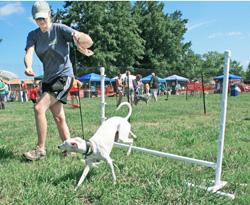Ninety-three-degree head bore down from Saturday’s sun on about 300 dogs and 1,000 spectators as they prepared for the day’s Olympic events on the field in front of N.C. State University Club.
And the Olympians were feeling the sun’s effects. In the shade of the event’s main refreshment tent, a woman shared a bottle of water with Bubba, who drank about half of it.
Another contestant walked toward the entryway, owner in tow, trying to head back to the car.
It was 10 a.m., and the games had only just begun as the contestants — Raleigh-area dogs — their owners, and students and faculty of the Veterinary School geared up for the next five hours of scheduled events.
The weather didn’t stop the dogs from competing, though, and it didn’t stop spectators coming out to cheer for their favorite contestants, according to Joan Hunt, president of the Student Chapter of the American Animal Hospital Association.
This year’s turnout exceeded expectations, according to Bobbi McQuown, president-elect of SCAAHA, which coordinates and hosts the Dog Olympics each year. Last year’s event brought about 600 people, she said, but that was a low turnout due to the day’s rain.
McQuown said the group started planning for this year’s Dog Olympics last fall, and will start planning next year’s event soon.
Entry cost $1 for people and $6 a dog — a fee that covered competition in one event and a photo of the dog in the winner’s circle. It was $1 for each extra event the dog competed in.
After the club pays for its own expenses, the proceeds — which Hunt said totaled more than $3,000 — will be split among six animal rescue groups.
These groups set up their tables along the outer edge of the fences was a line of booths. Each was set up to inform both pet owners and those who came purely as spectators about the consequences of improper animal care.
Some of the evidence was physical. Behind one table, sponsored by 2PawsUp, sat three dogs that had been taken from animal control shelters — those that, once full, euthanize animals that have not been adopted after a certain amount of time — on the day set aside for euthanization.
“The Dog Olympics gave us a chance to expose our animals, who need to be adopted,” Betsy Dunnabant, 2PawsUp’s dog foster coordinator, said. “It gives us a chance to raise awareness for what’s going on in local shelters.”
These dogs represent an exception to a national statistic. Animal shelters euthanize three to four million cats and dogs each year, according to the Humane Society. That means out of the six to eight million animals that come into animal shelters, about 50 percent come back out.
It’s a direct effect of overpopulation, Jessica Stall, president and founder of 2PawsUp, said.
Stall, a first-year student in veterinary medicine, moved from upstate New York to North Carolina two years ago. When she arrived, she noticed a substantial difference in the amount of animal control shelters.
“There aren’t a lot of kill shelters there,” she said. “They euthanize, but not for space.”
It’s different in North Carolina, she said, a state in which many animal shelters will euthanize animals not just for aggression and disease, but also for a lack of places to keep these animals while they wait for someone to adopt them.
She attributed the difference to a less common knowledge about standard spaying and neutering procedure and the state’s naturally warmer climate, which lends itself to a longer animal breeding season.
Stall, who disagrees with euthanizing animals for space purposes only, started to do something about it last June.
On the day Harnett County Animal Shelter was scheduled to euthanize its animals, she went and picked up those on the list. She’d already lined up foster homes — places these animals could stay until someone could permanently adopt them. Adoption, the final leg in the process, occurred primarily through posts on Craigslist and meetings between the foster family, the animal and the potential pet owner.
It became a routine, and more people joined her cause. So many, in fact, that they urged her to create an organization.
She did. In December, 2PawsUp became an official non-profit organization — one that can receive donations and discounted rescue rates on spaying and neutering procedures so the foster family doesn’t have to take on all adoption expenses.
Since that month, her organization has taken about 300 to 400 animals from kill shelters, spayed or neutered them, and put them in new homes, according to Megan Rygel, 2PawsUp’s cat foster coordinator.
“Almost all of ours come from situations where they’re about to be put to sleep,” Rygel said.
And with donations — from both individuals and from the portion of the Dog Olympic’s proceeds — Stall said she hopes 2PawsUp will grow even larger by the time she graduates with a concentration in small animal and shelter medicine.
“All our policies will be the same,” she said. “But we really do aim to have our own facility.”
Until 2PawsUp can afford a facility, the organization plans to continue its efforts working through foster families and events like the Dog Olympics, which attracted an audience to the team’s table and allowed prospective pet owners to flip through a book of cats and dogs that had not yet been adopted.
One woman, Dunnabant said, even confirmed an adoption of one of the dogs sitting behind the table. She’ll pick the dog up on Tuesday.








